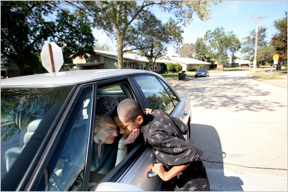Most older Americans would prefer to “age in place” – to live in their current homes with supportive services if necessary as an alternative to institutional long-term care. Indeed, people go to extraordinary measures to accomplish this goal. While many consider aging in place suitable, others find it a hollow victory, particularly when it occurs in a home that poses physical, financial or emotional challenges and makes meaningful connection with family, friends, neighbors and the community difficult or impossible. For this and other reasons, an increasing number of people now envision a third way—“aging in community.”
In short, “aging in community” presents a proactive, grassroots model that intentionally creates supportive neighborhoods to enhance well-being and quality of life at home and as an integral part of the community for people of all ages and abilities, particularly elders. Aging in community promotes a deliberate consciousness to be “a darn good neighbor.” Relationships between community members are informal, voluntary and reciprocal, and therefore, sustainable over time. Aging in community promotes social capital - a sense of social trust and interdependence enhanced over time through positive interactions and collaboration in shared interests and pursuits. Elders’ wisdom and experience are recognized and honored and opportunities are promoted to share this with others in the community.
A great example of an aging in community neighborhood, is Generations of Hope in Rantoul, Illinois. The visionary founder, Brenda Krause Eheart, recently won the 2008 Heinz Award for her success in building a “community-based model for adoptive families and senior citizens.” Yesterday, the New York Times featured
an article and slide show of this innovative program.
In the Wins Days to come, I look forward to sharing more about other emerging models of aging in community.
-- Janice Blanchard, MSPH

Based in a shuttered Air Force base in Rantoul, Ill., Generations of Hope matches elderly people to serve as surrogate grandparents for children in foster care. For Irene Bohn, 84, a retired schoolteacher, the role of beloved grandmother to Angelo Laws, 9, and his three siblings, has been the happiest and most important of her life.(Photo: Sally Ryan for The New York Times)
.jpg)



I have believed in NORCs and retirement communities more so than just "aging in place".
ReplyDeleteI enjoyed this article but could not get the slide show to work. There is an economy of scale in NORCs and communiities that is financially sustainable in todays economy and tsunami growth of folks like me.
But there is neighborhood spirit, pride, relationships (bad and good but stimulating), resources to help and catch someone before that fall too far. They offer a chance for a person to become a leader again, help others, make a diffence, continue to grow and so on then just living in a house.
I had heard about the Rantoul project, its ups and downs of project development, and the driving force of Eheart in making it happen - she certainly deserved the prize. To me, what is appealing about the "aging in community" concept (and, "aging in place" still works for me too, although I appreciate the distinction) is that its philosophy does not rely on big projects but rather can be accomplished by linking what already exists. Any believer in the aging in community concept can go back and change their world, their community, even if it is just a little bit but in the right direction. In discussions of "aging in community" I sometimes hear proponents looking for funding and better governmental coordination and sitting in place waiting for the day the dollars will come from DC, or the state. For now, we can change our worlds. You don't have to wait for permission or a structure or funding to adopt a philosophy. Just do it, and it will change the steps you take. Cheers to Eheart for investing and succeeding in this one big gigantic step in the right direction.
ReplyDeleteI remember reading about this community several years ago, when it was in the early stages of development and was excited to see such a creative and socially productive use of the property.
ReplyDeleteI am so, so glad to know that the project has been successful. Intergenerational relationships do so much for all concerned! Elders can benefit from a new sense of involvement and purpose, younger generations have an opportunity to learn from elders and assist them when needed, and children benefit enormously from the relationships they have with elders. This group of foster children has especially critical needs.
Brenda Krause Eheart's vision and tenacity are inspirational. While the property may be unusual, the need for affordable housing and supportive environments is not. I have to believe that this model can be adapted, based on the available "real estate" and socio-economic needs of a community and hope more planned, sustainable, intergenerational communities are the result!